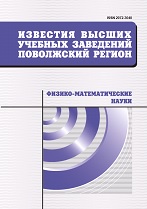|
Physics
Features of impurity magnetooptical absorption spectra in a multiwell quantum structure with $D_2^-$-centers in the presence of dissipative tunneling
V. D. Krevchik, E. N. Kalinin, P. V. Krevchik, T. A. Gubin, M. B. Semenov, V. A. D. Daud, A. V. Razumov
Penza State University, Penza
Abstract:
Background. The topicality of researching impurity resonant states and their optical features in multiwall quantum structures (MQS) is associated with an outlook of development of new sources of stimulated radiation at impurity transitions. The aim of the work is to theoretically rsearch the impact of an external magnetic field and dissipative tunneling on the energy spectrum of impurity resonant $D_2^-$-states in quantum wells, as well as on impurity absorption spectra of MQS with $D_2^-$-centers. Materials and methods. Curves of dependence of resonant $D_2^-$-states' binding energy on magnetic field size, as well as photoionization spectra of $D_2^-$-centers were built for GaAs/AlGaAs structures, alloyed by shallow Si donors. Calculations of the dependence og $D_2^-$-states' binding energy on magnetic field size and dissipative tunneling parameters were carried out within a model of zero-radius potential in effective-mass approximatio. Calculations of a coefficient of impurity magnetooptical absorption for MQS were carried out in the first order of the perturbation theory taking into account Lorentzian broadening of energy levels. Results. It is shown that a magnetic field leads to stabilization of resonant $D_2^-$-states in quantum wells in conditions of dissipative tunneling. The authors have revealed a high sensitivity of medium binding energy of resonant $D_2^-$-state and broadening of resonant levels to such parameters of dissipative tunneling, as phonon mode frequency, temperature, external medium interaction constant. It is shown that as the temperature and phonon mode frequency rise, the edge of impurity absorption band shifts into the long-wave spectral region due to a decrease of medium binding energy of the resonant g-state of $D_2^-$-center, and an increase of the external medium interaction constant leads to a shift of the photoionization threshold into the short-wave spectral region, which is associated with a growth of the resonant g-state's life span. Conclusions. In a magnetic field there occurs an opportunity to effectively control life span of resonant $D_2^-$-states in quantum wells, which is caused by a sufficiently strong dependence of the dissipative tunneling probability on B value. Existence of resonant $D_2^-$-state in GaAs/AlGaAs quantum wells, alloyed by shallow Si donors, is possible in conditions of dissipative tunneling.
Keywords:
GaAs/AlGaAs quantum wells, multiwall quantum structures, impurity resonant states, resonant $D_2^-$-states, magnetic field, dissipative tunneling, medium binding energy of resonant g-state, broadening of resonant level, coefficient of impurity magnetooptical absorption.
Citation:
V. D. Krevchik, E. N. Kalinin, P. V. Krevchik, T. A. Gubin, M. B. Semenov, V. A. D. Daud, A. V. Razumov, “Features of impurity magnetooptical absorption spectra in a multiwell quantum structure with $D_2^-$-centers in the presence of dissipative tunneling”, University proceedings. Volga region. Physical and mathematical sciences, 2016, no. 2, 103–123
Linking options:
https://www.mathnet.ru/eng/ivpnz248 https://www.mathnet.ru/eng/ivpnz/y2016/i2/p103
|

| Statistics & downloads: |
| Abstract page: | 45 | | Full-text PDF : | 8 | | References: | 15 |
|




 Contact us:
Contact us: Terms of Use
Terms of Use
 Registration to the website
Registration to the website Logotypes
Logotypes








 Citation in format
Citation in format 